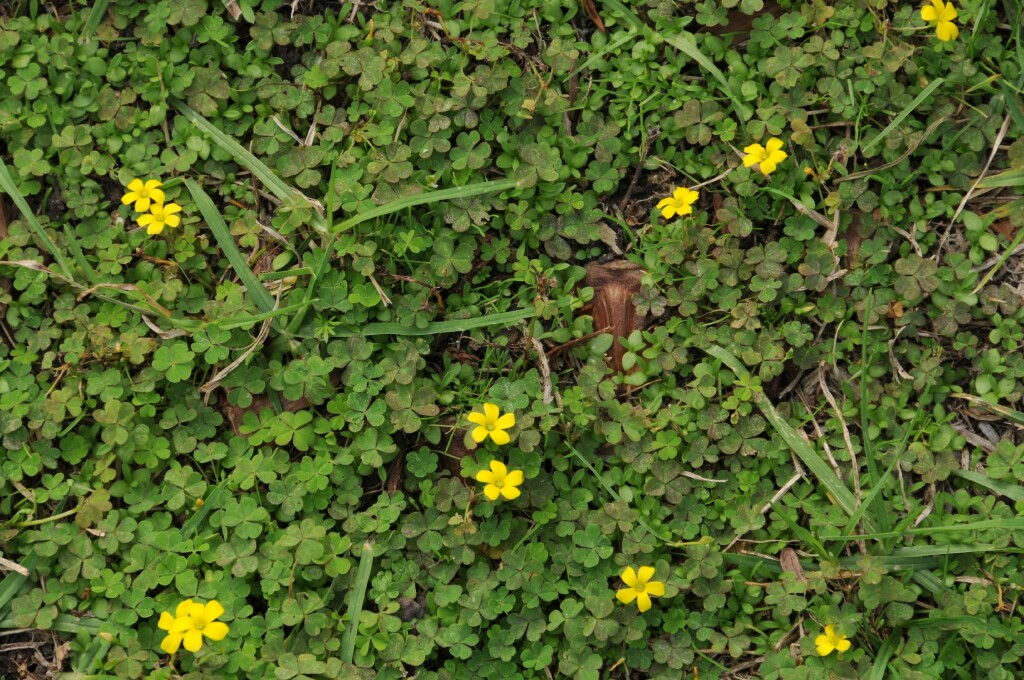Oxalis exilis
A.Cunn. Shade Wood-sorrelHerb with stems creeping or ascending, often rooting at nodes, to 35 cm long, very sparsely antrorse-hairy; taproot absent or poorly developed, rarely stout; bulbils absent. Leaves cauline, tufted, 3-foliolate; leaflets sessile, cuneate-obcordate, (2.5–)3.5–6(–13) mm long, 3–10(–16) mm wide, bilobed, usually green, more or less glabrous above, pubescent below, margins ciliate, sinus to c. one-third leaflet length, lobes obovate, divergent, apices obtuse, 2–3 mm apart; petioles 1–9 cm long, with antrorse hairs; stipules to c. 2 mm long, conspicuous, with apex lobed or truncate, or inconspicuous with apex tapering abruptly to pedicel, ciliate. Inflorescences axillary, flowers 1- or rarely 2 per peduncle, held more or less at leaf level, or slightly above; peduncles at least as long as leaves, antrorse-hairy; pedicels erect or deflexed in fruit (but capsule erect). Sepals oblong, 1.5–3 mm long, often ciliate. Petals 4.5–10 mm long, yellow. Capsule (5–)6–8(–13) mm long, 2–3 mm diam., ovoid to conical to broad cylindrical, usually moderately retrorse-hairy, sometimes with longer, scattered, patent, septate hairs, seldom glabrescent or glabrous; seeds (1.0–)1.2–1.8 mm long, transversely ribbed, ribs (4–)6–10(–13), narrow, grooves V-shaped, narrow and deep, uniformly coloured, brown to dark brown, ribs without greyish or whitish lines or blotches, except in the variant from disturbed sites. Flowers mainly Oct.–May.
LoM, MuM, Wim, GleP, Brid, VVP, VRiv, MuF, GipP, OtP, WaP, Gold, CVU, GGr, DunT, NIS, EGL, EGU, WPro, HSF, HNF, OtR, Strz, MonT, HFE, VAlp. Also NSW, Tas., Norfolk Island. New Caledonia, New Zealand. Naturalised in United Kingdom. Widespread throughout much of the State, often in winter-wet depressions or along stream banks on a wide range of soils. Occasionally a garden weed, sometimes densely mat-forming in lawns.
A variable species with several variants. Plants from more mesic habitats are often much more robust, with larger leaflets than those from drier inland areas but, generally, leaves of this species are the smallest among the Oxalis corniculata complex. Oxalis exilis generally also has smaller flowers and capsules than other members in the O. corniculata complex. Another variant occurs often in lawns and disturbed habitats. This variant is poorly represented in herbarium collections. It is long rhizomatous, and has whitish lines and or blotches on the seed ridges, a character shared with a form of O. corniculata (that is currently known only from garden beds urban Melbourne), with which it can be confused. This variant of O. exilis also has the smallest leaves and flowers among the forms of O. exilis. O. exilis can be recognised by its usually long creeping stems, which are very sparsely antrorsely hairy, the usually 1- or occasionally 2-flowered inflorescence, the inflorescence which is usually held more or less at leaf level or slightly above, and the relatively short capsules. Large-flowered forms of O. exilis can be confused with O. rubens, but it differs from O. rubens in having shorter capsules compared with the relatively long capsules in O. rubens, and the seeds have V-shaped rather than U-shaped grooves, and the leaves are usually green in O. exilis rather than glaucous or grey green as in O. rubens. The two species also have different habitat preferences, with O. rubens confined to coastal dunes and scrub. The relationship between O. exilis and O. perennans also warrants investigation.
 Spinning
Spinning




